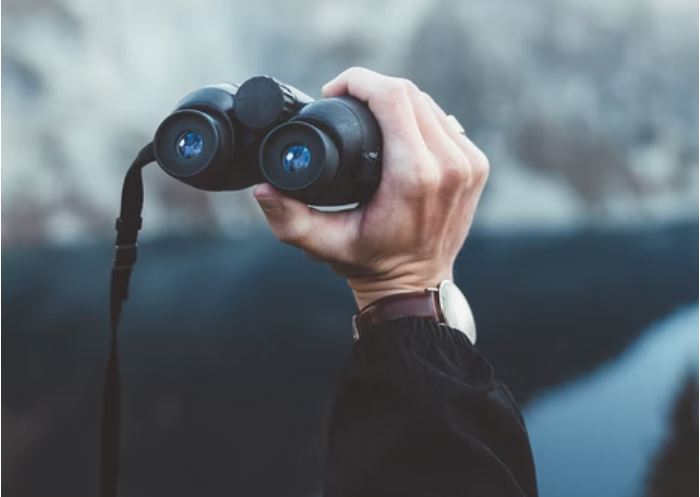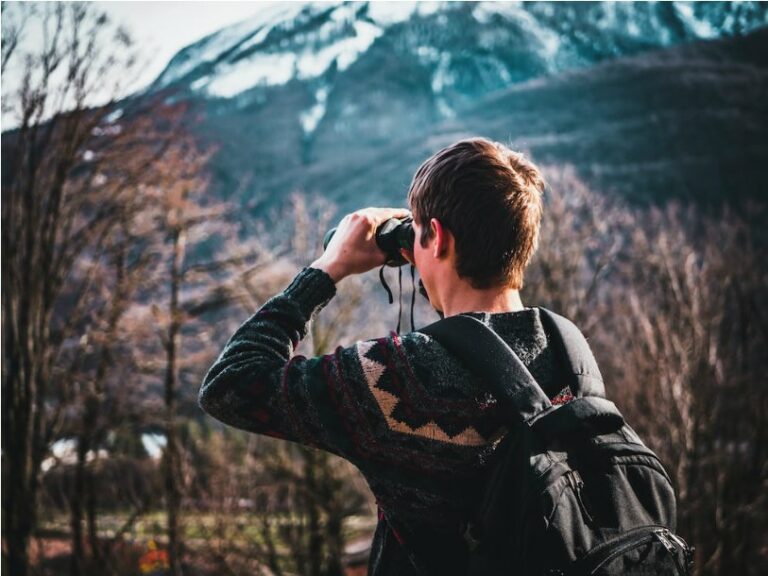We’re getting ready for birdwatching this summer, and we’re sure some of you are too! Whether you plan to observe wildlife or simply want a better view of the horizon, binoculars are a pretty handy tool to keep around.
There are many features about binoculars you may not know, and there are some things you should think about before buying the first pair you see on the shelf.
Below, we’ll share everything we know about binoculars to help you find and buy a pair that’s right for you and your upcoming activities.

Quick Navigation
ToggleUnderstanding Various Binocular Specs
Not all binoculars are made the same. There are a few different components on a pair of binoculars to look out for before you make a purchase.
Magnification
The magnification of your binoculars is the level of depth your binoculars are able to enlarge the image you are viewing. For example, if a pair of binoculars claims their magnification power is 8x, that means the object you’re looking at will look eight times closer to you than it would with your eyes alone.
The average range of a pair of binoculars is anywhere between 6x and 12x, but some binoculars can go even higher, up to 180x.
Higher magnification also means a less stable and sharp image. Shaky hands look much more significant when you’re zoomed in more, so you either need stabilized binoculars or a stand to put the binoculars on.
Binoculars with higher magnification should also take image brightness into account. The more you zoom, the less light that reaches your eyes, so images can look dimmer or darker. High-quality binoculars should still appear reasonably bright if they have magnification as high as 16x.
Objective Lens
The objective lenses are at the front of each barrel on your binoculars. Your objective lens is essential for gathering light properly, and is responsible for image brightness.
The size of your objective lens decides how much light it is able to take in at once. The larger the lens is in diameter, the more light the lens can take in, and the brighter the image you will see.
Larger lenses also have a greater field depth, which means more objects at a distance will appear in focus without you having to refocus everything.
Make sure you think about lens size when you consider what you want to use your binoculars for. If you want to go sightseeing, larger lenses will let you see more clearer the object of focus even in low light.
We recommend getting binoculars that have at least 32mm lenses, as you’ll have a much easier time seeing images. Though 42mm lenses are on full-size binoculars and will give you even greater sight.
The second number of a pair of binoculars’ specification tells you how many millimeters in diameter the objective lens is. So, a pair of binoculars that says 8×42 has an objective lens diameter of 42mm. Objective lenses usually range anywhere between 30 and 50mm.
Field of View
Your field of view is how wide the image you can see through your binoculars is at one time.
The more zoomed in you are, the less of the surroundings you can see. However, binoculars with a wider field of view will let you see more than binoculars with a more narrow field of view.
Narrow fields of view do still have an advantage. We find that binoculars with more narrow fields of view have more magnified and detailed views of what’s in front of them, so they’re great if you want to focus on something specific, like when birdwatching, rather than observe an entire landscape.
Field of view is usually specified in degrees or as a measurement of distance. The larger the degree, the greater the scene will appear, so a 7-degree field of view will be larger than a 4-degree field of view.
Other pairs may use distance to say something like, “400 feet at 1,000 yards,” which means you can see 400 feet of the scene when you zoom in to a specific distance of 1,000 yards.
Some binoculars have an adjustable field of view, so you can have the best of both worlds.
Remember that the size of your binoculars’ lenses and the strength of your magnification can both impact your field of view. Those wanting a larger field of view should opt for large lenses (42mm or greater) and lower magnification.
We highly recommend a pair like this if you plan to do lots of different things with your binoculars, such as bird watching, sight viewing, hunting, or whale watching.
Exit Pupil
On the other end of your binoculars from the objective lens is where the exit pupil is.
The larger your exit pupil is, the more light will be able to enter your eyes. This means you’ll see a brighter picture. For the brightest picture possible, you want a pair with large objective lenses and large exit pupils!
Exit pupils are measured in millimeters just like objective lenses, and are calculated by dividing the size of the objective lens by the pair’s magnificent power.
Luckily, these two things go hand in hand. Larger lenses naturally mean larger exit pupils, so the real focus here is on the objective lens.
Keep in mind that you may not always need giant lenses and exit pupils. If you plan to use binoculars in well-lit areas, the size matters much less as it will be very bright anyways.
If you plan to use them in the dark or at night, you’ll definitely need large lenses though. Aim for a minimum of 42mm.
Tripod Compatibility
Some binoculars are able to be attached to a tripod so you don’t have to worry about shaky hands interfering with your view.
If you want to use a tripod for your binoculars, you need to double-check that they’re designed to be mounted on a tripod. Usually, they will come with a mounting hole or threaded socket in the pair for you to attach them to a tripod.
You’ll also need a tripod adapter to attach to these points to hold the binoculars and tripod together. Always make sure your binoculars are compatible with a setup like this before purchasing them.

Eye Relief & Glasses Compatibility
When we talk about eye relief, we’re talking about the distance between the eyepiece lens and your eye. This is especially important if you wear glasses.
If you wear glasses, longer eye relief is essential, as looking through binoculars with short eye relief can be very uncomfortable. It can also cause difficulty seeing the full field of view through your binoculars.
Longer eye relief results in your binoculars being a bit more forgiving in terms of eye placement, so you’ll see the entire field of view much more easily with glasses or otherwise unusual eye placement.
Most eye relief is anywhere between 10-15 millimeters, but those with thicker glasses lenses, and frames may need an eye relief anywhere between 15-20 millimeters.
Some binoculars also have adjustable eyecups for people who wear glasses, so you can accommodate them more easily while wearing your glasses. Always be sure to try out a pair in the store if possible before purchasing them.
What Binocular Designs and Styles Are There?
You want to pick the right binoculars for your needs, so here’s everything we know about their different designs and styles.
Porro Prism Binoculars vs. Roof Prism Binoculars
These are two of the most common designs of binoculars.
First, the porro prism style has an offset prism system, which means the objective lenses and eyepieces are actually not in a straight line.
They’re really more shaped like a V or W, which allows for better light transmission and a wider field of view. They’re a great choice for those who really want great optical performance.
Roof prism binoculars are fully straight through, where everything is in line with one another.
Roof prism binoculars are popular as they’re able to be slimmer and more compact, so they tend to be easier to carry and are a bit more ergonomic. They’re also more solidly constructed due to their simple design, so they are less likely to get damaged or misaligned over time.
Really, you’re choosing between the convenience of size and durability versus optical quality, so you’ll have to weigh the pros and cons depending on your preferences.
For example, a durable, light pair is likely perfect for mountain climbing, so you may want to choose roof prism binoculars. If you don’t mind a larger pair for sightseeing, porro prism binoculars may be a better choice.
Compact vs. Mid-Size vs. Full-Size
There are also some different sizes of binoculars to think about.
Compact binoculars are the smallest kind you can get. These binoculars usually have objective lenses ranging between 20-32mm so they’re extremely lightweight and easy to carry. They also fit easily in your backpack or even a large pocket.
Compact binoculars are great for portability, so they’re best used for activities like hiking, climbing, or other traveling. However, they don’t take in as much light, so your image won’t be as bright as it would be with larger pairs.
Mid-size binoculars are a size up from compact. These binoculars normally have lenses between 32 and 42mm and are a good balance between portability and optical quality.
They have better light-gathering ability due to larger lenses, but aren’t heavy enough to be a big hassle while carrying, so they’re a good all-around choice for many people.
Full-size binoculars are the largest option available. These binoculars have lenses that are 42mm or larger and are the best at gathering light, giving you the best optical quality possible. They’re a favorite for birdwatching, stargazing, and other wildlife observation where attention to detail is important.
However, the trade-off is that full-size binoculars are much heavier due to their lens size. You may have issues traveling with them over extended periods, or you may prefer to use them with a tripod so you don’t tire your arms after a bit of use.
Protection Features for Binoculars
Waterproof & Fog-Proof Binoculars
Beautiful scenery can happen in any weather! We’ve certainly been caught exploring out in the rain before, and we’ve realized how important it is to have gear that can withstand different types of elements.
Waterproof binoculars can withstand the rain, using an O-ring to seal the housing to prevent any moisture or dust from getting inside.
Many waterproof binoculars are also fog-proof, which means they’re filled with dry gas like nitrogen or argon to prevent fog from building inside.
Waterproof binoculars tend to last longer than ordinary binoculars because of their durable materials. Spills, drops, and weather exposure won’t hurt waterproof binoculars like they will regular ones, so they’ll last for a long time.
Shockproof Binoculars
Those of you who tend to be a bit clumsy will want to pay attention here. Some binoculars are more shockproof than others, which means they’re less likely to break when being banged or dropped.
Look at the construction of binoculars to see if they’re made from rubber armor or polycarbonate, which prevent shock when being dropped or vibrated. This ruggedness can help your binoculars last much longer than if they were made from cheaper or more ordinary materials.

What to Consider Before Buying a Pair of Binoculars
We’ve bought many pairs of binoculars before, so here are some things to consider before making a purchase.
Purpose and Use
You should definitely think about what you plan to use your binoculars for. Do you want to look at landscapes, or do you want to go birdwatching?
Narrow field of view and high optical power is great for looking at specific objects, but larger fields of view are better for landscapes.
Or, if you want to use them while hiking or fishing, you’ll want to look for shockproof and waterproof binoculars. So think about your wants and which features you need!
Comfort
Your comfort matters when it comes to exploring. Make sure that any pair of binoculars you get are comfortable for you, whether in terms of carrying them or putting them to your eyes.
If you plan to travel a lot, smaller and lighter binoculars are great to not weigh you down. If you wear glasses, longer eye relief will help you stay comfortable as you look through them.
Warranties
Some binoculars may come with warranties or extra customer support.
Warranties may have different lengths of coverage and types of damage they actually cover, so make sure you’re clear on these before using your binoculars or making a claim.
How Much Should I Spend on Binoculars?
Before heading to the store, you’re going to need to set a budget for your binoculars. How much do you want to reasonably spend, and for what type of binoculars?
Most basic binoculars can cost anywhere from $50 to $150. These are great for beginners, those wanting casual use, or those with a smaller budget for their travels. They don’t have superb optical quality, but they will still work well for most purposes.
Mid-range binoculars range anywhere between $150 and $500, and this gives you a much better selection of features to choose from. This is where you’ll find binoculars that are waterproof and shockproof, and where you’ll find pairs better suited for darker viewing conditions.
Those who want a good pair for hobbyist purposes or who have higher budgets will likely go for mid-range binoculars.
High-range binoculars cost anywhere between $500 and $2,000 or more. These binoculars are of the highest quality and are best for professionals like geologists and meteorologists, or those who travel seriously and want the best view possible.
Remember that all binoculars are different, and a price tag doesn’t dictate whether a pair is of good quality. You’ll want to look at their individual features and reviews to figure out if they’re good enough for your needs.
Binoculars Recommendations and Reviews
Getting a perfect pair of binoculars for your nature expedition or wildlife spotting could make your trip to The Rockies, Yellowstone or anywhere around the world that much more incredible. Imagine the view when you get to spot that moose or bear far in the distance!
We’ve gone on multiple wildlife and outdoor trips, so trust us when we say a good and trusty pair can make a big difference in your experience, rain or shine. If you need a bit more tips, here are some reviews and recommendations to recommend you.
Binoculars by Specifications:
Binoculars by Price:
Binoculars by Usage:
Final Thoughts
Whether you plan to birdwatch or enjoy the mountains a little closer, binoculars can really enhance your outdoor experience.
Indeed there are lots of features to think about when it’s time to buy a pair of binoculars. As long as you think about your personal usage needs and what key features you’re looking for like portability or comfort, there’s definitely the perfect pair out there for you.
Be sure to tell us below if you’ve bought a pair recently, and what you like most about them!


